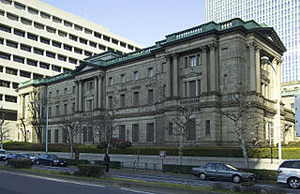
The Bank of Japan had a difficult start into 2016. The latest data shows that inflation in the last quarter of 2015 was lower than expected. Furthermore, doubts are increasing about the recovery of the economy. At the end of January, BOJ Gov. Haruhiko Kuroda surprised markets by announcing negative interest rates for certain commercial bank deposits at the BOJ. On March 1 Japan started to sell government bonds with a yield below zero. Market observers expect even bolder steps later this year.
What are the chances that Kuroda’s policies to lift inflation will be successful? In this article I argue that it is time for the BOJ to rethink its strategy. Continuing unconventional monetary policy is risky as success becomes more and more unlikely and an exit more and more difficult.
The stated goal for the aggressive monetary policy of the BOJ is to achieve 2 percent inflation. We know from basic macroeconomics that inflation can have different sources. One is an upward shift in aggregate demand; another one is an increase in the money supply. Aggregate demand in Japan has been sluggish.
In a country with a falling population and wealth mainly held by the elderly, a major increase in aggregate demand is unlikely to happen. Policymakers have therefore relied on the expansion of monetary supply. Most macroeconomists agree that under normal circumstance the expansion of money supply is one of the most effective way to generate inflation. But why have inflation rates have been stubbornly low in Japan, despite the massive expansion of the monetary supply?
One main reason is that the additional money supplied by the BOJ does not find its way into the economy. Instead, it is put back into the coffers of the central bank through deposits made by commercial banks. As a consequence, the balance sheet of the BOJ is constantly increasing. The only positive growth effect of the monetary expansion has come from the weak yen. Japanese companies have been successfully increasing their worldwide exports. Corporate earnings have risen considerably. But companies have been reluctant to share their higher earnings by increasing salaries. Domestic aggregate demand thus remained almost unaffected by the export boom.
Why have companies shied away from increasing wages? At first sight it looks like a paradox. Companies have enough earnings to increase wages and in addition they are faced with a tight labor market. For every 120 open jobs, only 100 applicants can be found.
The only plausible reason why wages are not increasing substantially are expectations about the future of the monetary policy. Companies expect that the current monetary policy is truly unconventional and temporary. Exiting the current expansive monetary policy will result in a stronger yen, and thus in lower export revenues. Companies thus perceive the current rise in profits due to higher exports simply as a windfall.
The latest trends of the strengthening yen seem to confirm their expectations. Continued strengthening of the yen will dampen exports and profits of Japanese companies.
The past weeks have also shown that financial markets have lost their faith in the effectiveness of monetary policy to stimulate the Japanese economy in a sustainable manner. Monetary policy has worked in conjunction with fiscal policy to prevent the Japanese economy from slipping into recession. However, as fiscal stimulus is fading and structural reforms are still not being implemented, the financial markets no longer believe in the effectiveness of monetary policy. Reaching a 2 percent inflation is thus becoming increasingly difficult.
In a last attempt to change market sentiments, the BOJ followed other central banks by offering negative yield bonds. It is hard to see why markets should believe that this policy change will trigger a change in inflation expectations.
What options are left for the BOJ? One option that the BOJ tried last year was to adjust the price index. Last summer, the BOJ blamed the historically low oil prices for the low inflation and developed a new consumer price index that omits oil prices in the consumption basket. The new index first yielded better results. But six month later, even when applying the new inflation index, the increase of prices in Japan was well below expectations.
Another option would be to adjust the target. The 2 percent goal has no strong empirical foundation in economics. It was a rule of thumb that was first introduced in New Zealand in 1988 to ensure that the economy would not slide into deflation.
Since then the 2 percent rule has been adopted by other important economies, such as the eurozone and Japan. In the case of Japan, however, which has notoriously faced low inflation rates for the past three decades, a 2 percent objective seemed extremely ambitious. The longer the BOJ attempts to achieve this target using panoply of instruments without accomplishing much, the more the markets lose their faith in BOJ’s policy.
Rather than becoming more aggressive, the BOJ might consider lowering the inflation target. A lower target would help to restore the BOJ’s credibility. If explained properly the market interruption would be small.
Lowering the inflation target would also indicate that the BOJ’s role in stimulating the economy has its limits. Monetary policy has never worked as an instrument to increase the competitiveness of a country in the long run.
Central banks are able to provide monetary stimulus to mitigate short-term downfalls in demand. However, in the long run only structural reforms can make a country competitive again. And only structural reforms can bring a growth in productivity, and eventually demand.
Abe’s third arrow is becoming increasingly urgent. The time window provided by Kuroda’s unconventional monetary policy is closing — maybe more quickly than some had expected or wished for.
This article was first published by The Japan Times (online on March 7 and print on March 8).







Comments are closed.